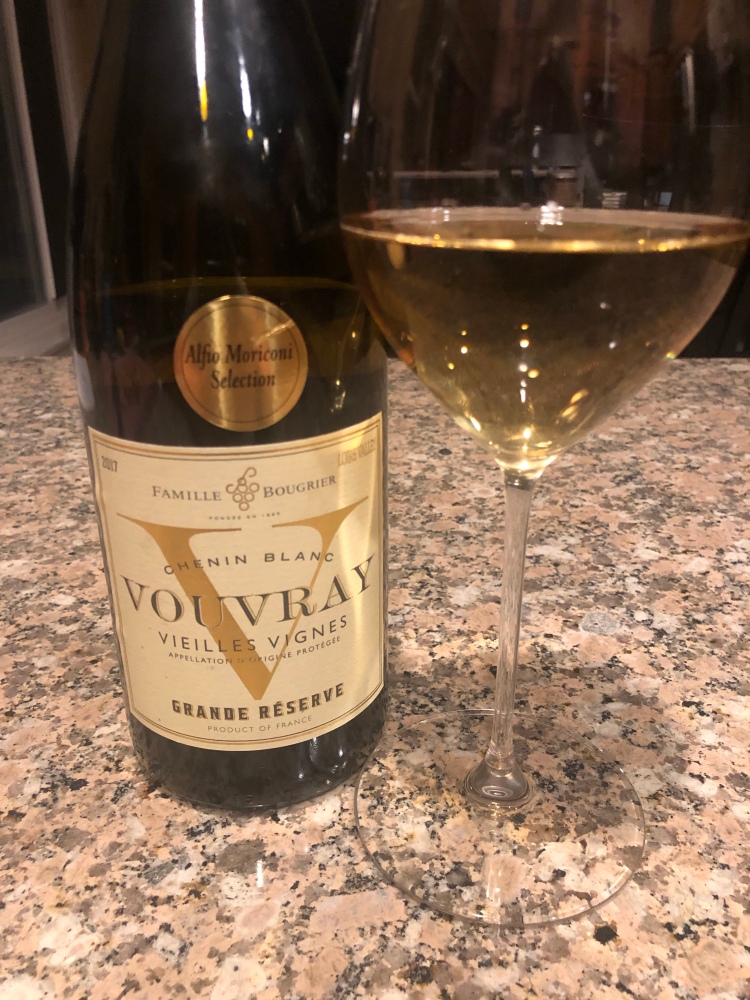
This week is revisiting Chenin Blanc. Previously, we tried the grape as it is produced in South Africa. This week, we can see how that version differs from those of Vouvray. Vouvray is an area within the Loire Valley in Northern France that produces Chenin Blanc. Just like with other wines of France, the name of the wine indicates the geographic area. The geographic designations indicate the grapes used because French wine law mandates which grapes can be grown in these areas. Unfortunately, one must become familiar with this translation when shopping or it can become quite confusing when perusing the French wines at a wine shop. Chenin blanc from France can vary greatly in level of sugar (from dry to sweet) and because of its cooler climate, it tastes more of fresh apple unless the grapes are left on the vine past normal harvest. These grapes have a lower level of acid and a higher level of sugar. This additional ripening time, and sometimes the presence of noble rot (botrytis), can lead to tastes more reminiscent of stone fruits (such as peaches or apricots) and tropical fruit (such as pineapple or mango). Vouvray can also be produced as a still wine or with varying degrees of sparkling.
Wines have been produced in Vouvray since the 4th century, when Saint Martin founded the Marmoutier monastery. It wasn’t until the middle ages that wines from this area became known as Vouvray. It was during this time period that it is believed the first Chenin Blanc vines were brought over from the Anjou region of the Loire Valley. At this time, the Catholic Church maintained the vineyards. Later, in the 16th and 17th centuries, Dutch merchants took a liking to the grape variety and decided to plant vineyards all around the area so they could take their wine to Rotterdam, Paris and London to sell or export.The next advancement in the area came in the 17th and 18th centuries when the building of wine cellars began with particular types of rocks that kept the areas at a steady cool temperature. This allowed wines to be aged and resulted in the rise of sparkling wines. In 1936, Vouvray became one of the first regions recognized by the governing body of French wine, INAO, when they bestowed AOC status to the area.

This week, I had a 2017 Famille Bougrier Grande Reserve Vouvray paired with smoked salmon pappardelle. The challenge with Vouvray is the lack of labeling when it comes to the amount of residual sugar (an indicator of sweetness) in the wine. This can create a bit of a challenge when trying to pair it with food. Never hesitate to ask the merchant where you are shopping because getting a bottle home to find it is dessert sweet but you need a dry version with your main dish can be very disappointing. The bottle I have selected is slightly off dry. This works with the dish because of the salt from the smoked salmon. When I poured my first glass, I noted the brilliant medium gold color. The wine lacked legs on the sides of the goblet which indicated it probably had a lower alcohol content. It smelled of honeysuckle, toasted almonds, meyer lemon juice, yellow pears, and nutmeg. This off dry, medium bodied wine is well balanced by the pleasant acidity that softens the fats in the sauce and salmon. The flavors of ripe apricot and honey add a wonderful opposition to the salmon as well. The lemon juice in the sauce, and the lemon pepper seasoning on the salmon are equal to the acid in the wine and complement the touches of citrus in the wine beautifully. The subtle floral notes of orange blossom and honeysuckle are delightful with the arugula and garlic. This pairing is fantastic and I need someone to take my plate and glass of wine away before I make a pig of myself!
-TheLooseTannin